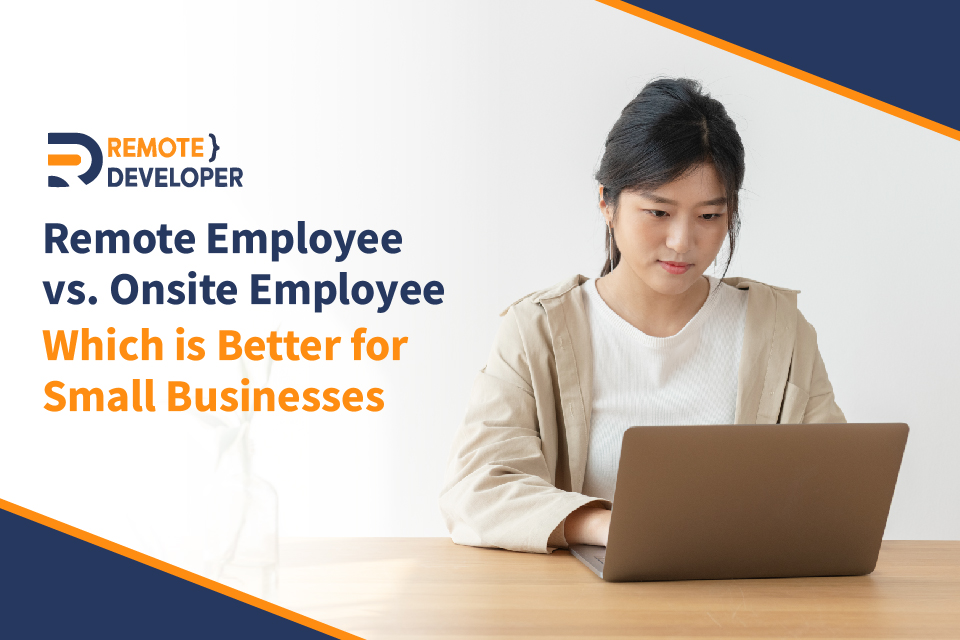Remote work has been a popular setup for many companies even before the COVID-19 Pandemic. It provides several benefits, such as companies can save money, attract more talent, increase productivity, and be great for the environment. However, not all businesses are sold out with these benefits, especially small companies. Many believe that the latter is better when it comes to remote vs onsite employees. Yet, it choosing between the two is a difficult decision to make. Likewise, let’s explore in this article the difference between hiring Remote vs Onsite Employees and which option should help your small business choose.
What is a Remote Work setup?
A remote work setup is how a company’s workforce is distributed geographically. In this setup, employees work from home or from another location, not the company’s headquarters. The remote work setup has been around for a while now. It has become an integral part of many companies business models. Remote work is a popular option for small businesses, but it also has challenges. The benefits of remote work are clear, and many companies have embraced it. In the future, we will see more and more companies adopting remote work as it provides many benefits for both employees and employers 
Pros of Hiring Remote Workforce
Many companies in the world are starting to embrace hiring remote employees. This is due to several advantages such as access to a broader pool of remote talent, reduced overhead costs, and increased productivity.
1. Access to a broader pool of remote talents
Many businesses are looking to hire remote vs Onsite employees as it provides a broader pool of hidden talents from around the globe. Since remote work is becoming more and more common, many agencies and freelancers are adapting to remote work. Companies now can hire candidates with a wide range of expertise and background. Remote working can provide access to a broader pool of talents that may not be available in your local area.
2. Lower operational costs
Hiring remote vs onsite employees can lower operational costs. Since remote work offers flexible working arrangements, employers can reduce the number of office spaces. It can lower office expenses such as equipment maintenance, electricity bill, water expenses, etc. Moreover, it is beneficial not only for employers but also for employees. Since they have a choice to work anywhere, most choose to work from home. They can save more money instead of spending their resources commuting and food.
3. Easier growth and more productivity
When it comes to remote work vs office productivity, remote working wins! Remote workers are generally more productive than employees in the office setting. A study conducted by Stanford on 16,000 workers found that working from home increases productivity by 13%. Increased output can help the company achieve its goals quickly and save time and resources.
Cons of Hiring Remote Workforce
While the remote workforce undeniably provides excellent benefits, it also comes with many drawbacks that may affect your small business. It is essential to consider these, especially for a small business with limited resources and experience. Here are some of the drawbacks you need to look out for in hiring remote employees.
1. Harder for a team to collaborate and bond
Remote work can sometimes make it harder for teams to collaborate. Even with collaboration tools for a remote team, having no face-to-face contact can limit the team’s communication skills and ability to share ideas.
2. Risk of error
In connection to lack of communication, hiring a Remote vs Onsite Employee can cause more errors than usual. In a remote setup, miscommunication can happen. Remote workers are more likely to make mistakes because they are not in the office and don’t know what is going on. This means that they cannot get help from their coworkers or supervisors.
3. Difficulty maintaining the confidentiality
Having a remote vs an onsite employee can be a struggle for many reasons. Employees are not in the same physical location as their coworkers and bosses in a remote work environment. This means they can’t always be sensitive to what they say or do. This situation can result in a data breach or being spread to a competitor. In addition, since they are using their own home connection, there is no strict security protection. Data are prone to hacking/
What is an Onsite Work Setup?
Onsite work setup is the traditional type of work setup followed by companies. Most onsite employees must report to the office to do their work. Usually, companies need employees to work onsite due to their career or business, such as education, health, retail, or manufacturing. In addition, some employees are required to relocate and set up their own workstations in a company’s offices. 
Pros of Hiring Onsite Workforce
Like hiring remote employees, hiring onsite employees offers a lot of benefits. And these are:
1. Direct control
Onsite working can give the company direct control. This is because the company can have a more hands-on approach to managing its workforce. For example, they can monitor their employees and ensure that they are working at the right time. They can also keep track of their work hours and how much time they spend on each task. Employees also benefit from this as it is easier for them to manage their work hours and tasks in an organized way.
2. Better Teamwork
Onsite working can offer better teamwork and a more collaborative environment. The proximity of people in the exact physical location creates a sense of camaraderie and helps to build relationships.
3. Ensure confidentiality
The need for confidentiality is one of the reasons why companies are moving to onsite working. In today’s time, employees are more likely to access sensitive information and data. This means that they have a higher chance of leaking confidential information. However, with onsite working, companies can ensure better confidentiality. They can monitor where their employees are sending information and minimize access to sites that may harm their equipment and database.
Cons of Hiring Onsite Workforce
The benefits of working in an office are the social aspect of it. You get to interact with people you wouldn’t otherwise have met, and there’s a sense of community among the workers. However, working in an office can be challenging to do as well. It can be hard to concentrate and focus on your work with so many distractions. Here are 3 cons of hiring an onsite workforce.
1. High costs in utilities
Onsite working can be costly. It involves high travel expenses, accommodation, and food costs. But there are some ways to minimize the costs. Firstly, you can choose to work from home or a coworking space if it is available in your area. Secondly, you can find a company with an office in your city or town and work remotely for them for a few days each week. Lastly, you can ask the company if they have any remote positions available to allow you to work from home on certain days of the week.
2. Less efficiency
Employees who work offsite are more likely to be distracted. It is a known fact that being in the office with more people makes communication more fluid, resulting in a disturbing and noisy working environment. In addition, an onsite work setup can be a disadvantage to introverted employees as it lacks privacy, unlike remote working. Introverted employees may feel uncomfortable to work, which can result in anxiety and stress.
3. Low morale
Office setting may increase employees’ stress and anxiety, which tends to lead to low morale. In an office setting, employees tend to feel more under pressure from their superiors or colleagues. Thus, they always end up stressed, which leads to decreased productivity. In addition, commuting from home to work can cause stress. By the time they arrive to work, workers would feel more tired, leading to decreased output.
Hire Your Remote Workforce with Us!
Hiring a remote vs an onsite employee certainly comes with many differences. Both offer great benefits but come with drawbacks that may affect productivity. When choosing between the two, it is best to consider factors such as budget, needs, and industry. If you are looking to hire a remote workforce in IT, contact us now!

